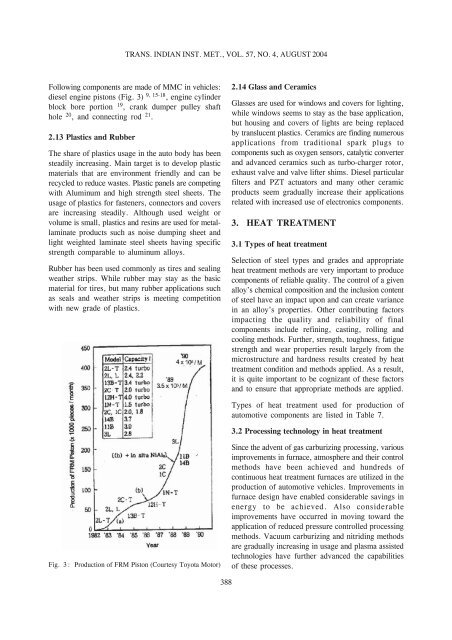HEAT TREATMENT OF AUTOMOTIVE COMPONENTS: CURRENT ...
HEAT TREATMENT OF AUTOMOTIVE COMPONENTS: CURRENT ...
HEAT TREATMENT OF AUTOMOTIVE COMPONENTS: CURRENT ...
You also want an ePaper? Increase the reach of your titles
YUMPU automatically turns print PDFs into web optimized ePapers that Google loves.
TRANS. INDIAN INST. MET., VOL. 57, NO. 4, AUGUST 2004<br />
Following components are made of MMC in vehicles:<br />
diesel engine pistons (Fig. 3) 9, 15-18 , engine cylinder<br />
block bore portion 19 , crank dumper pulley shaft<br />
hole 20 , and connecting rod 21 .<br />
2.13 Plastics and Rubber<br />
The share of plastics usage in the auto body has been<br />
steadily increasing. Main target is to develop plastic<br />
materials that are environment friendly and can be<br />
recycled to reduce wastes. Plastic panels are competing<br />
with Aluminum and high strength steel sheets. The<br />
usage of plastics for fasteners, connectors and covers<br />
are increasing steadily. Although used weight or<br />
volume is small, plastics and resins are used for metallaminate<br />
products such as noise dumping sheet and<br />
light weighted laminate steel sheets having specific<br />
strength comparable to aluminum alloys.<br />
Rubber has been used commonly as tires and sealing<br />
weather strips. While rubber may stay as the basic<br />
material for tires, but many rubber applications such<br />
as seals and weather strips is meeting competition<br />
with new grade of plastics.<br />
2.14 Glass and Ceramics<br />
Glasses are used for windows and covers for lighting,<br />
while windows seems to stay as the base application,<br />
but housing and covers of lights are being replaced<br />
by translucent plastics. Ceramics are finding numerous<br />
applications from traditional spark plugs to<br />
components such as oxygen sensors, catalytic converter<br />
and advanced ceramics such as turbo-charger rotor,<br />
exhaust valve and valve lifter shims. Diesel particular<br />
filters and PZT actuators and many other ceramic<br />
products seem gradually increase their applications<br />
related with increased use of electronics components.<br />
3. <strong>HEAT</strong> <strong>TREATMENT</strong><br />
3.1 Types of heat treatment<br />
Selection of steel types and grades and appropriate<br />
heat treatment methods are very important to produce<br />
components of reliable quality. The control of a given<br />
alloy’s chemical composition and the inclusion content<br />
of steel have an impact upon and can create variance<br />
in an alloy’s properties. Other contributing factors<br />
impacting the quality and reliability of final<br />
components include refining, casting, rolling and<br />
cooling methods. Further, strength, toughness, fatigue<br />
strength and wear properties result largely from the<br />
microstructure and hardness results created by heat<br />
treatment condition and methods applied. As a result,<br />
it is quite important to be cognizant of these factors<br />
and to ensure that appropriate methods are applied.<br />
Types of heat treatment used for production of<br />
automotive components are listed in Table 7.<br />
3.2 Processing technology in heat treatment<br />
Fig. 3 : Production of FRM Piston (Courtesy Toyota Motor)<br />
Since the advent of gas carburizing processing, various<br />
improvements in furnace, atmosphere and their control<br />
methods have been achieved and hundreds of<br />
continuous heat treatment furnaces are utilized in the<br />
production of automotive vehicles. Improvements in<br />
furnace design have enabled considerable savings in<br />
energy to be achieved. Also considerable<br />
improvements have occurred in moving toward the<br />
application of reduced pressure controlled processing<br />
methods. Vacuum carburizing and nitriding methods<br />
are gradually increasing in usage and plasma assisted<br />
technologies have further advanced the capabilities<br />
of these processes.<br />
388
















